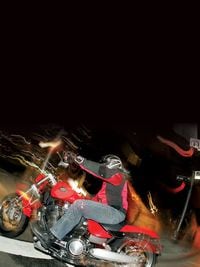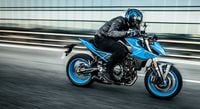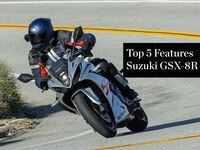Half the nation's highway fatalities happen at night, despite fewer vehicles on the road. Human vision is dramatically less efficient in low light, especially when it comes to judging distance. Some humans are tired. Others are drunk. Itinerant feral life-forms are never very bright, but most are startlingly solid. All that ads up to one very simple prime directive for safe travel between dusk and dawn: Slow down. If you forget all the rest of this, remember that much.
That means allowing a little more time for every maneuver between inserting key in ignition and taking it out again. Put some extra real estate between your front fender and the vehicle ahead so if/when some nasty surprise appears, you've got enough room to deal with it. Bright colors and strategically placed swatches of retro-reflective material make it easier for somnambulant drivers to see you at night. Still, the best way to live long and prosper is to assume you're invisible.
Tuning in to your surroundings is especially important when there's less light to work with. If you can't see why that van up ahead just swerved to the left, back off until you can. Better to slow down for nothing than run into something painful. Critters can be less so if you know what to look for. Thanks to a nifty reflective layer behind the retinas of most nocturnal vertebrates called the tapetum, glowing eyes on the road or shoulder are your cue to slow way down.
A few shifts from daytime riding technique can save your hide as well. Always use a bit of brake when slowing down, even if rolling out of the throttle and downshifting will scrub off the desired amount of speed. Why? A bit of brake light gives surrounding traffic a clearer picture of where you are and what you're doing. And use the high beam as much as you can without blinding other drivers. It's a whole lot easier to see and be seen that way.
Shifting to the back if you're riding in a group can effectively double or triple the reach of your headlights. And, speaking of which, bust out that owner's manual-we'll wait-and make sure your lights are aimed to factory specifications and in proper working order. That means clean, pristine lenses ahead of fresh bulbs front and rear. Get your personal kit in order as well. A tinted faceshield is suicide, but a clear one that's cracked or splattered with bug guts isn't much better. And if you think you're too tired to get from A to B without chemical assistance or singing "Ob-La-Di, Ob-La-Da" the whole way, stay home and wait for David Letterman.

/cloudfront-us-east-1.images.arcpublishing.com/octane/D2BDYKKNZ5GRHGDMI4PZTGRMME.jpg)

/cloudfront-us-east-1.images.arcpublishing.com/octane/UAY4WSZPOFDQRP4MCEXAKDFQOQ.jpg)

/cloudfront-us-east-1.images.arcpublishing.com/octane/X5CE3KSJHZHM5CUFGPZ7U26WB4.jpg)
/cloudfront-us-east-1.images.arcpublishing.com/octane/COWLTPGFAFGDDGJCTENYMA4VJM.jpg)
/cloudfront-us-east-1.images.arcpublishing.com/octane/H3PKUGPSUJFTND4RFPSI4OIDCE.jpg)
/cloudfront-us-east-1.images.arcpublishing.com/octane/UHGQA3MQDFCA3HLBWF7S76WH6Y.jpg)
/cloudfront-us-east-1.images.arcpublishing.com/octane/Q5EORCSTNFAVBJC4IYUHIKJTXQ.jpg)
/cloudfront-us-east-1.images.arcpublishing.com/octane/XIJ5FUFSP5A3NL7MOVZGJXAHC4.jpg)
/cloudfront-us-east-1.images.arcpublishing.com/octane/V5NZN3CGS5B5PPYFYJHIPAU5S4.jpg)
/cloudfront-us-east-1.images.arcpublishing.com/octane/CZE6ONOBU5E7HPIEEADU376C4M.jpg)
/cloudfront-us-east-1.images.arcpublishing.com/octane/UT4KL3SIYJBSPNHWJXTBE6MTGE.jpg)
/cloudfront-us-east-1.images.arcpublishing.com/octane/Q3UOIDZ22ZEVDBZUWGJXIMGJKI.jpg)
/cloudfront-us-east-1.images.arcpublishing.com/octane/YQM66WXZV5AAXNNOIUVOGVXZMY.jpg)
/cloudfront-us-east-1.images.arcpublishing.com/octane/J47NFTXNLFFGHELHZCUD2LCITA.jpg)
/cloudfront-us-east-1.images.arcpublishing.com/octane/NXPQBTLX3NCILKQ2GCFJYNIDEM.jpg)
/cloudfront-us-east-1.images.arcpublishing.com/octane/6U7NJLAYMRBZTIGNKWIA5OK2FQ.jpg)
/cloudfront-us-east-1.images.arcpublishing.com/octane/IYTZQWUROVC25IMTDEWUDQ5IQE.jpg)
/cloudfront-us-east-1.images.arcpublishing.com/octane/YJODDXEL2ZB5TENKPPN4BEYJAE.jpg)
/cloudfront-us-east-1.images.arcpublishing.com/octane/QEQQUZYNJFAIJB4DZFVFSNTCQ4.jpg)
/cloudfront-us-east-1.images.arcpublishing.com/octane/F4EEHDT3UZFKPLKVGDWMMPFEQE.jpg)
/cloudfront-us-east-1.images.arcpublishing.com/octane/J47U6OWNLBFBBG75A3ILAKFYZU.jpg)
/cloudfront-us-east-1.images.arcpublishing.com/octane/XWWQYTL3J5B7LKXDI354FFF4NQ.jpg)